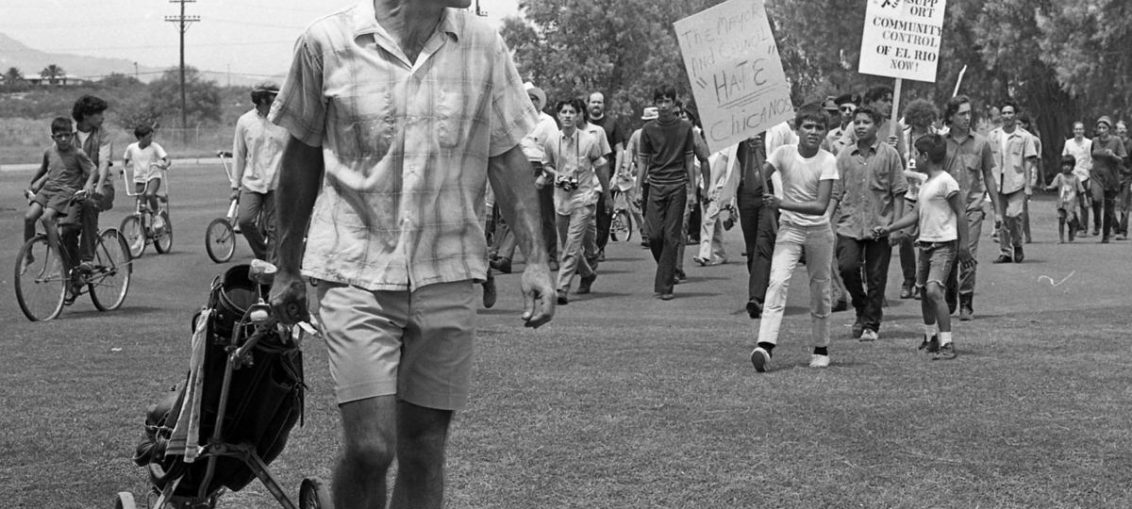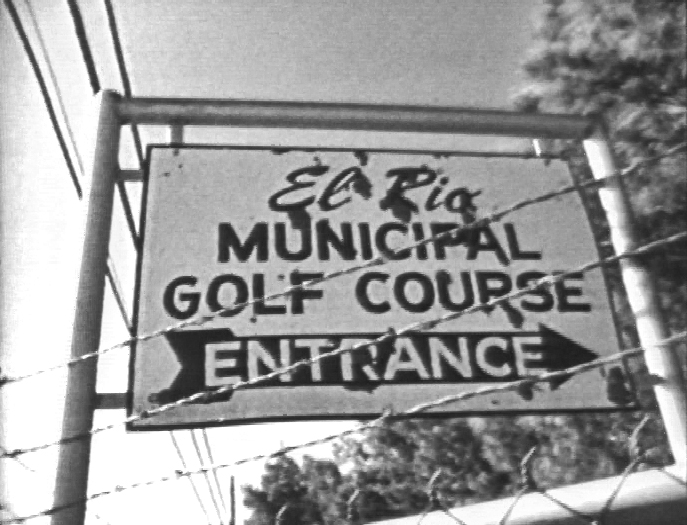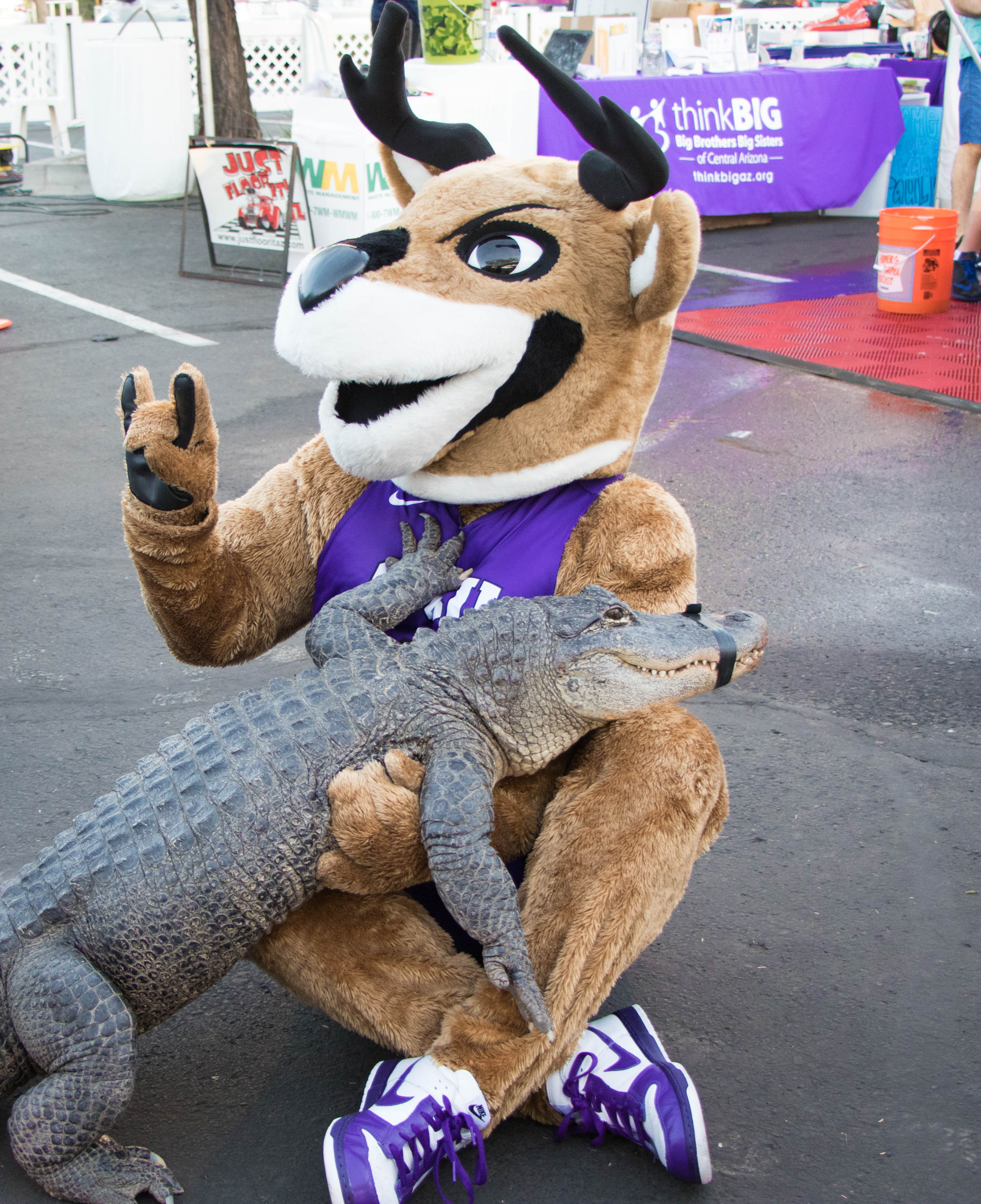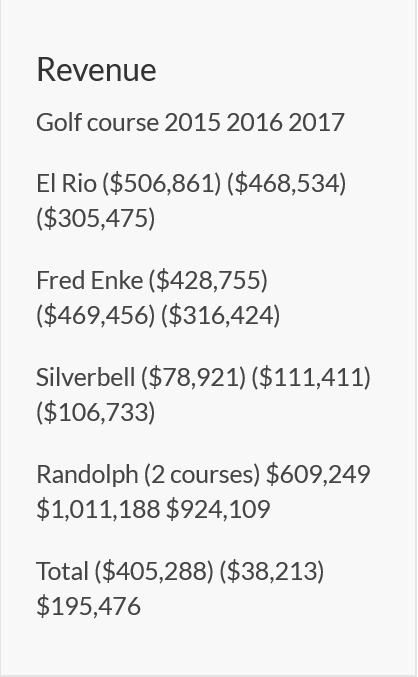
A quick Spanish lesson for you Canadian types here:
Rio Nuevo translates to New River and is the name of the downtown revitalization initiative introduced in Chapter 3.
El Rio translates to The River and is the name of one of Tucson City Golf’s four remaining municipal golf courses. El Rio exists on a chunk of land just to the west of Interstate 10 in Mayoral Election Favorite Regina Romero’s (of Chapter 4 fame) Ward 1 district.
Today we will be talking about El Rio Golf Course and a brief but impactful series of events in 2013 related to an effort by then-for-profit Grand Canyon University to establish a campus in Tucson at the site of El Rio which, at the time, was hemorrhaging cash (estimates were that El Rio was responsible for an over half-a-million dollar loss that year) — a practice that has continued unabated as the 2017 losses for the course ran at over $300K.
That’s right — Tucson ain’t got no money but they’re subsidizing golf. But that’s really neither here nor there. What is important, however, is understanding a little about the backstory of Tucson municipal golf (El Rio specifically) and the oddly-powerful neighborhood groups that somehow wield significant power and influence in a city that is desperately in need of tax revenue, decent jobs, and reduced liabilities.
 So let’s start with El Rio Golf Course. El Rio was is a short, flat, public course with a 3.7 rating on Golf Advisor. Originally constructed in 1934 as a private country club, El Rio became host to the first PGA event in town, the Tucson Open, before being acquired by the city and transformed into a muni in the late 1960’s. Since then, the midtown Randolph golf complex (featuring the Randolph North and Del Urich 18-hole courses), which went on to host the LPGA Welch’s Tucson Open/Championship from the early 1980’s until 2004, has become Tucson’s favorite and only profitable golf asset. El Rio, Silverbell, and Fred Enke can easily be argued to be numbers two through four in the city course rankings behind Randolph.
So let’s start with El Rio Golf Course. El Rio was is a short, flat, public course with a 3.7 rating on Golf Advisor. Originally constructed in 1934 as a private country club, El Rio became host to the first PGA event in town, the Tucson Open, before being acquired by the city and transformed into a muni in the late 1960’s. Since then, the midtown Randolph golf complex (featuring the Randolph North and Del Urich 18-hole courses), which went on to host the LPGA Welch’s Tucson Open/Championship from the early 1980’s until 2004, has become Tucson’s favorite and only profitable golf asset. El Rio, Silverbell, and Fred Enke can easily be argued to be numbers two through four in the city course rankings behind Randolph.
I won a closest-to-the-pin at Randolph North once so I’m partial to the city’s long course. But, again, that’s not what is important. What matters is that the above narrative is typically as much as anyone hears when the course closing conversation comes up. And, really, that should be enough. Randolph is a profitable enterprise and profits about $1.25 million to $1.5 million annually. The other three courses — all in need of serious capital improvements in the coming five to ten years (estimated for all courses is $20+ million in upgrades) — are the reason Tucson City Golf made only $200K in 2018.
A nd you know the accountants crunched every possible number to show the $7 million per year local entity in the black after a decade operating in the red. But, again, not the point.
nd you know the accountants crunched every possible number to show the $7 million per year local entity in the black after a decade operating in the red. But, again, not the point.
So let’s go all the way back to 2013. I know what you’re thinking, “Hey blax, that was the season Seattle got a team and won their first-ever Super Bowl, crushing the Broncos 43-8.” And you’re right. Others will complain that that was the year Green Bay won the North with a 8-7-1 record, holding off the 8-8 Bears. And, again, we’d be off discussing something that was not the point. Hit very hard by the real estate bubble bursting in 2008, Tucson and Pima County were years into suffering in 2013. As more diversified, educated, and responsive communities were ascending an economic recovery, Tucson was forced to sit tight and reap what had been sown. It could not offer a workforce that would attract the sought-after tech hubs many cities were counting on to regenerate their communities. It’s overall business-unfriendly reputation kept it from even being considered by opportunist corporations looking to relocate facilities and operations during a movers’ market. The Old Pueblo had survived on construction, tourism, and their local anchor employers — University of Arizona, Raytheon Missile Systems, Davis-Monthan Air Force Base, Pima County (including Pima Community College) — and they would count on these employers to pull them back to economic prosperity, relatively speaking.
But there was a problem, you see. Because these public employers (and grifting-at-the-public’s-teet Raytheon) would need federal dollars to help shore up their revenues to support payroll increases. And the President, facing a Republican House of Representatives, was black. And Social Security, as it continues to do today, was crushing our nation’s economic potential.

So Tucson was searching for a get-recovery-quick option. And then came to town an established business in a growing market who was very interested in making a substantial investment — including millions of dollars in construction projects plus creating hundreds of new jobs which would be required for the long term maintenance of the business. This interested business? Oh just a little THE LARGEST CHRISTIAN UNIVERSITY IN THE WORLD, Grand Canyon University, home of the Antelopes.

For those of you who are not familiar, GCU was founded in the 1940’s by the Arizona Southern Baptist Convention. Suffering financially after the turn of the century, the trustees approved the sale of the institution to Significant Education LLC (RTD Trading Tip: this traded on the NASDAQ under LOPE), making GCU the first-profit Christian university in the US — and the institution would go on to become the only for-profit school competing in NCAA Division I athletics. GCU, based out of west Phoenix (less than two miles from the Filiberto’s where the tweaker jumped in my truck), went on a spending tear with a focus on expanding their inherited student population of under 1,000 students to — whatever the max they could get. Their current enrollment is 70,000 students, 20K of which are on their Phoenix campus.
As part of their expansion, GCU spent millions in construction on their Phoenix campus (which is still ongoing, actually), expanded their online offerings, and pursued additional campus locations in northwest Phoenix, Mesa, and Tucson. So it was this simple. GCU wanted to expand from Arizona’s largest city to construct a separate location in Arizona’s second largest population center. And Arizona’s second largest population center wanted a business to come to town and do something — ANYTHING — to invigorate the economy. Win win, right?
Not in Tucson. Sure, things started off on the right foot: GCU held meetings with Tucson and neighboring upper middle class suburb Oro Valley without the public catching wind or raising a stink. For a multitude of reasons (the biggest being a little real estate term called location), Tucson was the clear front-runner to strike a deal with GCU. That’s right. For the first time since the mid 20th century when MLB Spring Training eyed the Old Pueblo, Tucson was a level negotiating partner on a pretty important business deal. Tucson could bring to the table a college town vibe; a workforce of experienced higher education bureaucrats; cheap wages; and the land required to build a college campus. GCU, according to soon-to-be-mayor City Councilwoman Regina Romero, “could create 1,000 jobs at salaries averaging $60,000.” That’s a big deal for the nation’s 6th poorest metropolitan area.
In fact, Romero was an early supporter of the GCU deal. As leaks began to reach the public, however, May 13, 2013 became the day the deal effectively died. This day was the first acknowledgement by the city that a deal with GCU for the El Rio land was on the table, as it was added to the May 14th city council agenda — just one day for the council meeting. Now, I don’t know if you all are familiar with activist triggers but even the illusion that you’re trying to ram something through without proper notice is a pretty surefire way to develop opposition. And opposition to the plan there was.
You see, the El Rio neighborhoods — namely Barrio Hollywood and Barrio El Rio — carry a sizeable amount of clout, especially when you consider that these areas are….not rich. But they are an effectively organized community and the El Rio golf course is like the symbol of their historical effectiveness. You see, when I mentioned that the city acquired El Rio for public use in the 1960’s, above, that only happened because of the protests and activism of the local neighborhoods (see banner image). To make a long story short, the democrats running in 1967 cut a deal with west side activists to get out the vote in return for public works upgrades to these neighborhoods which were lacking paved sidewalks, community centers, or a public park. When the democrats won election and did not deliver on their promises, activists began holding sit ins, protests, and, after finally moving to march on the El Rio greens, the city was forced to action and purchased El Rio as well as beginning construction on a nearby park and neighborhood center.
So, to these groups, El Rio is a bit of a third rail. And after the facts came out that the city was seriously considering turning their decades-old money pit trophy into a college campus, the mobilization was quick, fierce, and overwhelming. Admittedly, there were also objections from other community groups, such as gay and lesbian groups who opposed GCU’s anti-homosexual student code of conduct but, come on, it isn’t like these groups ever came out in mass against BYU coming to play NCAA contests against UA. Hell, I got a gay friend who received a degree from GCU (online) and there is no way in hell that place didn’t know he’s gay. They just saw he enjoys Chik-fli-A and, most importantly, his checks cash.
To highlight the weak argument for closing the door negotiations with GCU so early, you can read Romero’s May 28, 2013 letter from the local Arizona Daily Star here. It is, literally, 80% about the positives the GCU proposal could bring (justifying her consideration in the first place) before simply stating:
“Despite the many positives of Grand Canyon’s move to El Rio, I have always believed in listening to everyone. After hearing sincere concerns from my friends, allies and colleagues on this issue, I have decided against pursuing the opportunity further.”
 That’s it. Now, why was GCU not presented with a different location by the City of Tucson or one of the neighboring jurisdictions? Well, that doesn’t require a Peter King length multi-chapter dick joke blog feature — the University of Arizona and Pima Community College are strongly against a GCU campus in Tucson. This is simply editorializing now but I think they’d have killed the initial GCU proposal had they had they been aware of the discussions earlier on. And — again, just editorializing — I think it says a lot about the realistic potential of the GCU deal that negotiations were not immediately leaked out the moment GCU expressed interest with the city.
That’s it. Now, why was GCU not presented with a different location by the City of Tucson or one of the neighboring jurisdictions? Well, that doesn’t require a Peter King length multi-chapter dick joke blog feature — the University of Arizona and Pima Community College are strongly against a GCU campus in Tucson. This is simply editorializing now but I think they’d have killed the initial GCU proposal had they had they been aware of the discussions earlier on. And — again, just editorializing — I think it says a lot about the realistic potential of the GCU deal that negotiations were not immediately leaked out the moment GCU expressed interest with the city.
But we’ll take a closer look at the University of Arizona and it’s then-President next time. As for GCU, they would go on to build a student outreach Antelope Reception Center (ARC) in Mesa in 2014 and a second ARC in Tucson in 2015. GCU’s plans for a Tucson campus are indefinitely on hold. El Rio continues to maintain the “unacceptable status quo”, losing money annually and sitting on the city budget chopping block with a big fat asterisk next to it’s name — assuring that it will continue to be an economic drain for years to come. Barrio Hollywood and Barrio El Rio — which would have surely enjoyed increase real estate values similar to those of the neighborhoods surrounding GCU’s Phoenix campus — continue to be the straight up barrio.
Because this is what Tucson does when Tucson has any sort of opportunity presented to the city whatsoever.
[…] running a bit behind because I’m taking off tomorrow to drive blaxito & fam to Tucson so he can spend the next week or so at Grandma’s house. I’ve still got some […]
I fucking LOVE this series. I can’t wait for the next one.
I played one of the Randolph courses in 2001 or so. Right after it had hosted the LPGA so it was in really great shape.
This series is superb Blax. I had no idea it was the 6th poorest city.
Oh yeah. Poor and stupid.
This is fine and all, but when do we get another outback steakhouse?
–Steve Keim, probably
I went to Tucson for my 30th birthday, because it was the only decently accessible hiking destination in the US with a reasonable temperature average for February. I ate. I drank. I got hit on by 2 University of Arizona co-eds, presumably on a dare. It was kinda boring after a day on the trail.
Apparently I should have gone to a city council meeting if I was looking for excitement. I had no idea it was such a festering bowl of intrigue and villainy.